If you have access to Meyer lemons, and access to farm-fresh eggs, you’re cheating yourself if you don’t make Meyer lemon curd. Trust me!
I love lemon curd, and as a child growing up in England it was just as likely to be served on the table with toast in the morning, as jam or marmalade. Yes, you can, and should, eat lemon curd for breakfast. Or brunch. Or lunch. Or dessert. Honestly, there’s no wrong time to eat lemon curd, is there?
Store bought lemon curd, though, pales in comparison to homemade, and fortunately, making your own is actually very simple.
The only caveat is that this is a recipe where mise en place is very important. You need to prepare everything in advance, and have it to hand. Juice and zest your lemons, cube your butter, and prepare your ice bath before you start cooking the curd.
You can’t go running around the kitchen looking for butter, checking your Facebook page, or answering the phone. Don’t walk away from the curd while it’s on the stove. Lemon curd requires your undivided attention for the few minutes that it takes to make, but it’s worth it.
This recipe makes a generous amount of Meyer lemon curd. After all, who would make just a little lemon curd? If your double boiler is large enough, go ahead and double the recipe if you wish, as this recipe scales very well.
Meyer Lemon Curd
Yield: Approximately 2 Pints of Curd
Ingredients:
1-1/4 Cups freshly-squeezed Meyer lemon juice
Zest from 3 small, or 2 large, Meyer lemons, finely grated
2/3 Cup sugar
5 Large egg yolks
5 Large whole eggs
pinch of salt
15 tablespoons unsalted butter, cubed, at room temperature
Equipment:
Double boiler (or make your own with a large pasta pot, and a stainless steel bowl)
Stainless steel balloon whisk
Silicone spatula
Stainless steel fine-mesh strainer
Stainless steel ladle or large spoon
Instant read thermometer
1 Large, and 1 medium mixing bowl, to make an ice bath
Prepare two sterilized freezer-safe 1 pint canning jars, and their lids (see video below).
Put a few inches of water in the bottom of your double boiler, but not enough that the water touches the bowl or insert. Bring your double boiler to a steady simmer over medium heat.
Prepare your ice bath BEFORE starting the curd. Place a few cups of ice in a large bowl, with a splash of water, and set a medium bowl in the ice. Set a stainless steel strainer over the medium bowl so you’re ready to strain the curd into the chilled bowl as soon as it’s cooked.
Prepare the Curd
To make the Meyer lemon curd, in the bowl of your double boiler, combine Meyer lemon juice, and sugar, and whisk until the sugar dissolves.
Add the lemon zest, whole eggs, and yolks, and whisk over medium heat until the mixture reaches between 130-140 degrees.
Briefly remove the double boiler from the heat, and add the cubed butter.
At this stage you should change from using a whisk, to using a silicone spatula.
Return the double boiler to the stove, and stir to incorporate the butter, being sure to get the edges and the bottom of the bowl.
You may notice thickened custard on the edge of the spatula as the curd thickens. Don’t panic. That’s normal.
As the curd approaches 150F it will rapidly start to thicken, and you’ll have to work quickly and vigorously. The curd may not look perfectly smooth at this stage due to some thickened egg whites, and pieces of zest, but that is normal. Just keep stirring.
Continue stirring the curd until an instant read thermometer registers 170F, then immediately remove the curd from the heat.
Once you have cooked your curd to 170 degrees F, pour the entire mixture through a stainless steel sieve, to strain out the lemon zest and any cooked egg, into the chilled bowl set over an ice bath.
You’ll likely have to encourage the curd to go through the strainer with your spatula as it will already be quite thick.
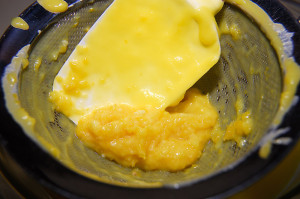
This is why! You want the finished curd to be smooth, and not have these bits of cooked egg, or zest
Once the curd is strained, using a CLEAN spatula stir the strained curd for a few minutes over the ice bath so that the mixture cools.
Ladle the cooled curd into sterilized jars, and secure the lids. Don’t overfill the jars if you will freeze the curd, or the jars may crack.
Go ahead, you can lick the bowl, and the spatula now. You deserve it!
The curd will continue to thicken as it cools, and can be refrigerated for up to 5 days. At that time any leftover curd must either be eaten, or frozen. If you have some extra, how about making a Meyer lemon meringue tart?
——————
The following helpful video demonstrates the boiling-water bath canning technique for preparing the jars, including basic required equipment:
Note that these jars of lemon curd, just like the preserved lemons, are NOT processed in the canner after sealing, as the curd would over-cook. Meyer lemons are less acidic than regular lemons, and this lemon curd must be kept refrigerated, or frozen, NOT stored on a pantry shelf!

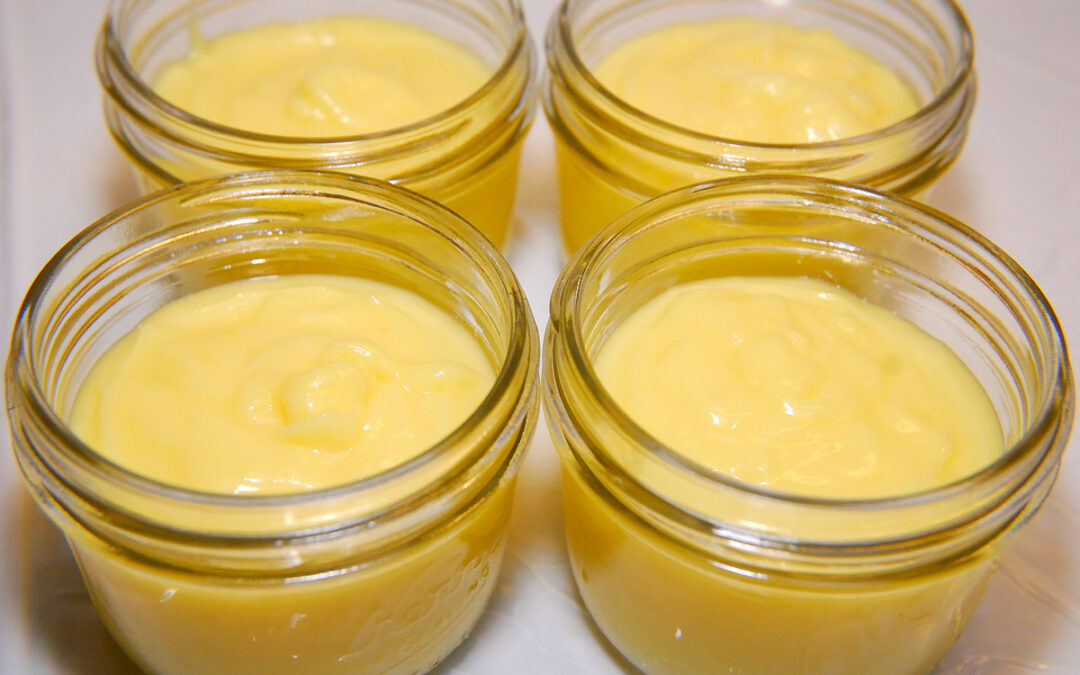
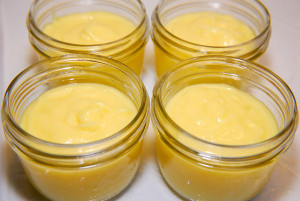
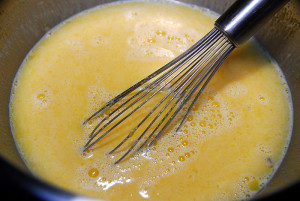
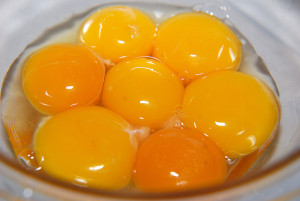

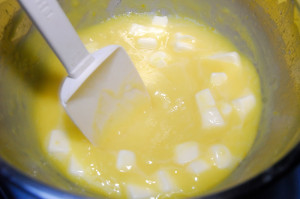

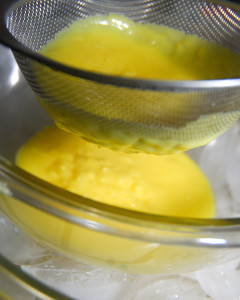








Oh that looks so delicious. I must find some time to give it a try. You always have the best recipes.
Thank, Carolyn! It is delicious, and quite habit-forming! 😉
I love lemon curd. I always make some with Meyer lemons when I can get them. And I could sit and eat it with a spoon any old time of day!
That the problem, any open jar around here is in serious danger of being emptied! 😉
OK now you are killing me Clare as I adore lemon curd….we would be eating it with a spoon…nothing else necessary.
Oh, I’ve been to known to squirrel away part of an open jar, pull out a spoon, and steal a bite, or three, when nobody is looking. It really doesn’t need anything other than a spoon to enjoy it! 😀